CHEVROLET CORVAIR 1965 2.G Owner's Guide
Manufacturer: CHEVROLET, Model Year: 1965, Model line: CORVAIR, Model: CHEVROLET CORVAIR 1965 2.GPages: 56, PDF Size: 22.29 MB
Page 31 of 56
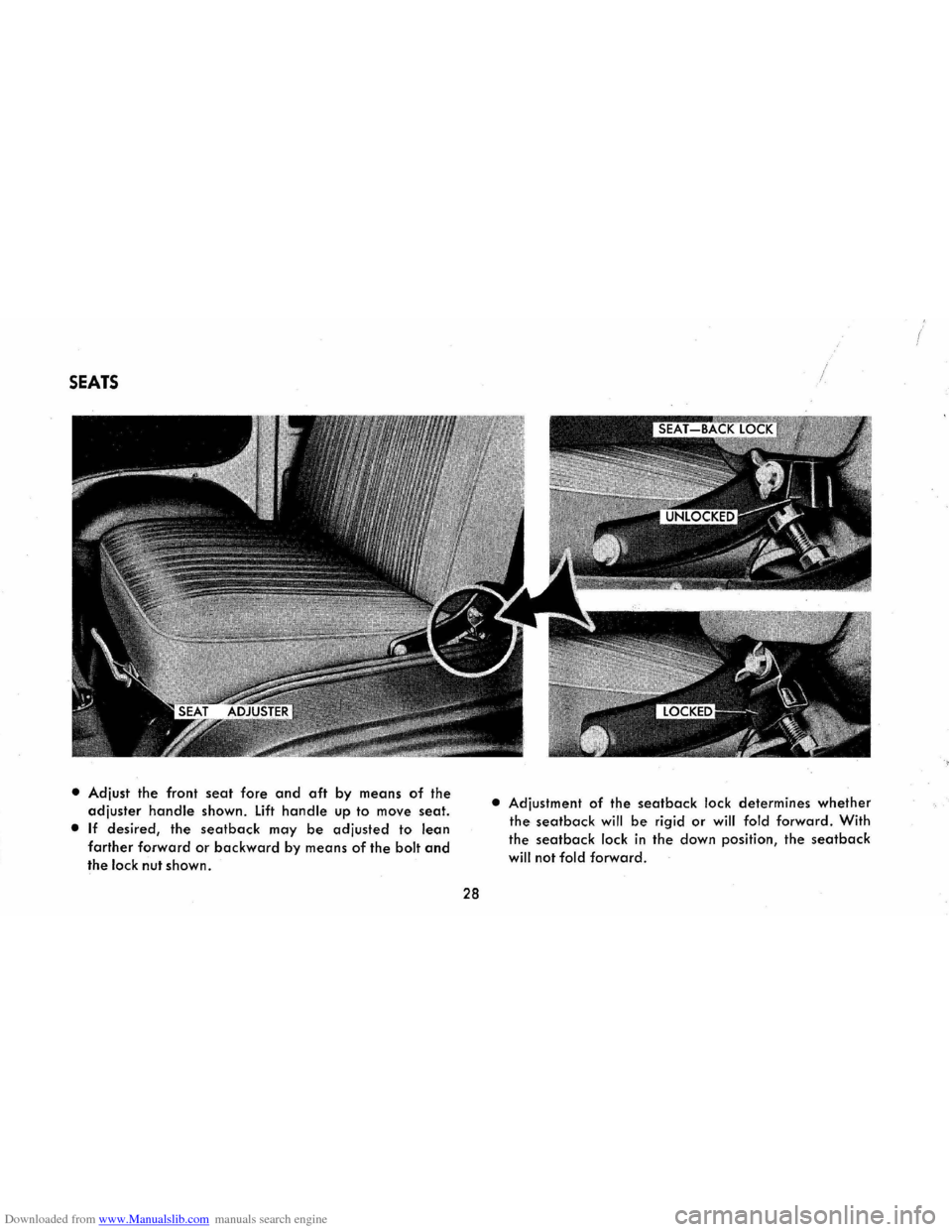
Downloaded from www.Manualslib.com manuals search engine SEATS
• Adjust the front seat fore and aft by means of the
adjuster handle shown. Lift handle up to move seat.
• If desired, the seatback may be adjusted to lean
farther forward or backward by means of the bolt and
the lock nut shown.
28
• Adjustment of the seatback lock determines whether
the seatback will be rigid or will fold forward. With
the seatback lock in the down position, the seatback
will not fold forward.
Page 32 of 56
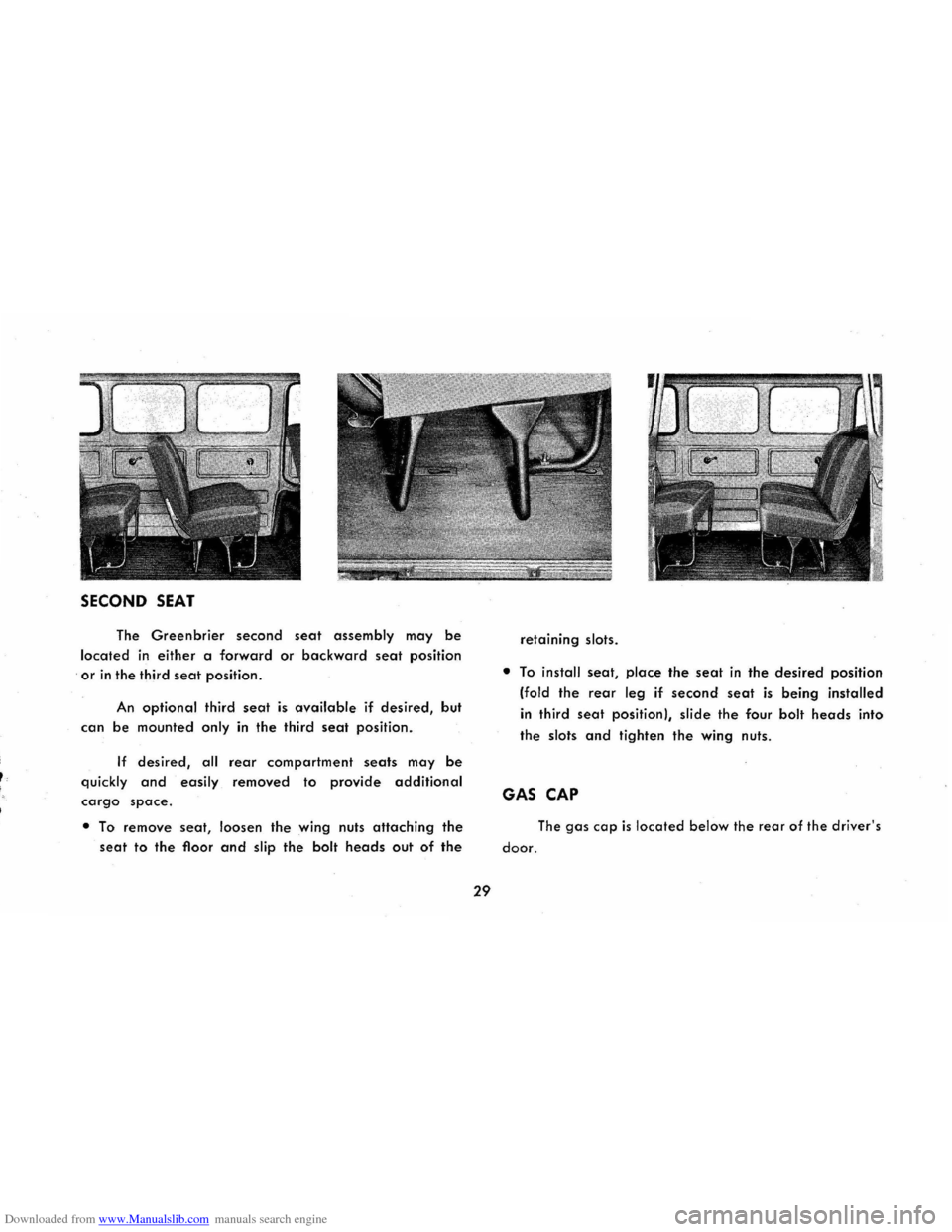
Downloaded from www.Manualslib.com manuals search engine I
t
SECOND SEAT
The Greenbrier second seat assembly may be
located in either a forward or backward seat position
. or in the third seat position.
An optional third seat is available if desired, but
can be mounted only in the third seat position.
If desired, all rear compartment seats may be
quickly and easily removed to provide additional
cargo space.
• To remove seat, loosen the wing nuts attaching the
seat to the floor and slip the bolt heads out of the
29 retaining
slots.
•
To install seat, place the seat in the desired position
(fold the rear leg if second seat is being installed
in third seat position), slide the four bolt heads into
the
slots and tighten the wing nuts.
GAS CAP
The gas cap is located below the rear of the driver's
door.
Page 33 of 56
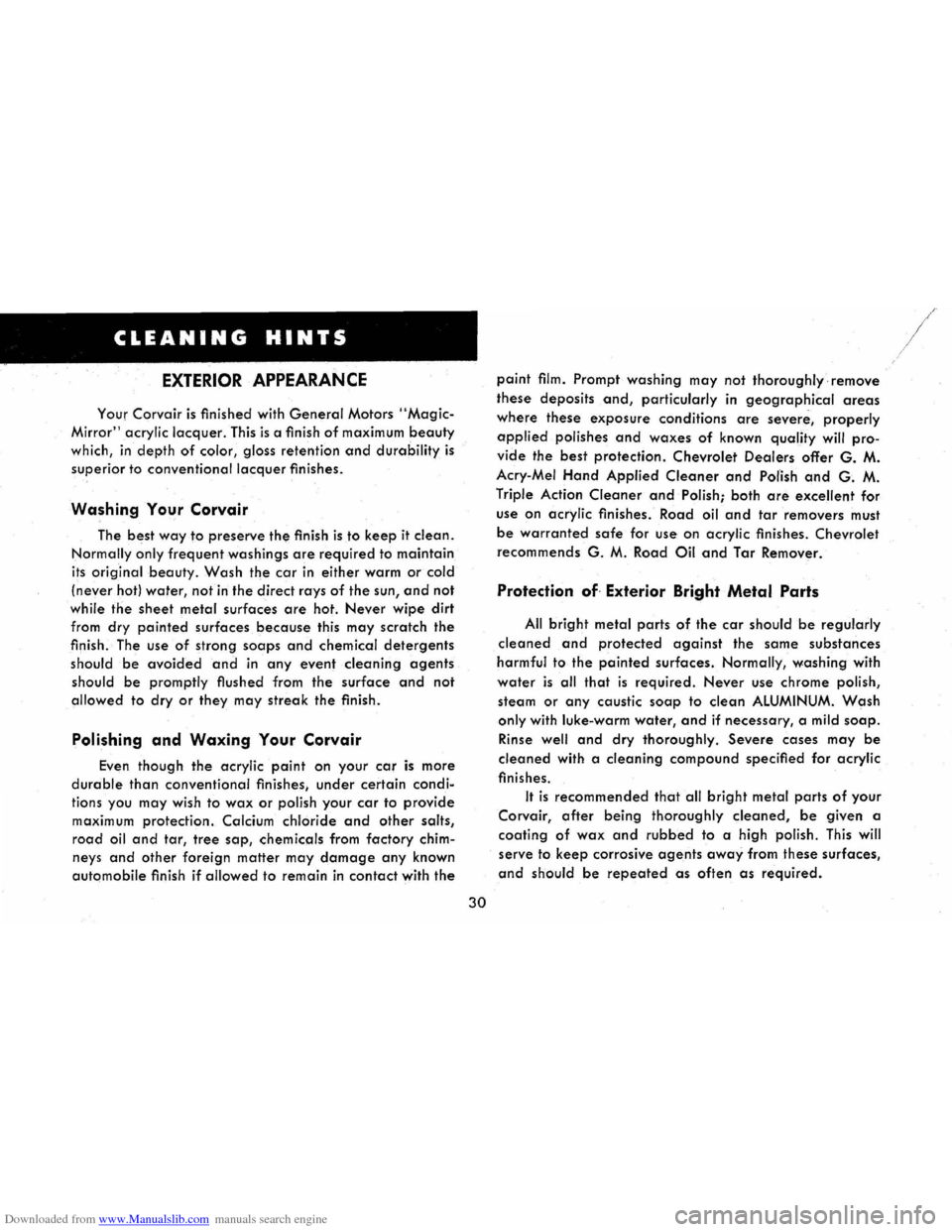
Downloaded from www.Manualslib.com manuals search engine CLEANING HINTS
EXTERIOR APPEARANCE
Your Corvair is finished with General Motors "Magic
Mirror" acrylic lacquer. This is a finish of maximum beauty
which, in depth of color, gloss retention and durability is
superior to conventional lacquer finishes.
Washing Your Corvair
The best way to preserve the finish is to keep it clean.
Normally only frequent washings are required to maintain
its original beauty. Wash the car in either warm or cold
(never hot) water, not in the direct rays of the sun, and not
while the sheet metal surfaces are hot. Never wipe dirt
from dry painted surfaces because this may scratch the
finish. The use
of strong soaps and chemical detergents
should be avoided and in any event cleaning agents
should be promptly flushed from the surface and not
allowed to dry or they may streak the finish.
Polishing and Waxing Your Corvair
Even though the acrylic paint on your car is more
durable than conventional finishes; under certain condi
tions you may wish to wax or polish your car to provide
maximum protection. Calcium chloride and other salts,
road oil and tar, tree sap, chemicals from factory chim
neys
and other foreign matter may damage any known
automobile finish if allowed to remain in contact with the
30
paint film. Prompt washing may not thoroughly remove
these deposits .
and, particularly in geographical areas
where these exposure conditions are severe, properly
applied polishes and waxes of known quality will pro
vide the best protection. Chevrolet Dealers offer G. M.
Acry-Mel Hand Applied Cleaner and Polish and G. M.
Triple Action Cleaner and Polish; both are excellent for
use on acrylic finishes. Road oil and tar removers must
be warranted safe for use on acrylic finishes. Chevrolet
recommends G. M. Road Oil and Tar Remover.
Protection of. Exterior Bright Metal Parts
All bright metal parts of the car should be regularly
cleaned and protected against the same substances
harmful to the painted surfaces. NormallY, washing with
water is all that is required. Never use chrome polish,
steam or any caustic soap to clean ALUMINUM. Wash
only with luke-warm water, and if necessary, a mild soap.
Rinse well and dry thoroughly. Severe cases may be
cleaned with a cleaning compound specified for acrylic
finishes.
It is recommended that all bright metal parts of your
Corvair, after being thoroughly cleaned, be given a
coating of wax and rubbed to a high polish. This will
serve to keep corrosive agents away from these surfaces,
and should be repeated as often as required.
Page 34 of 56
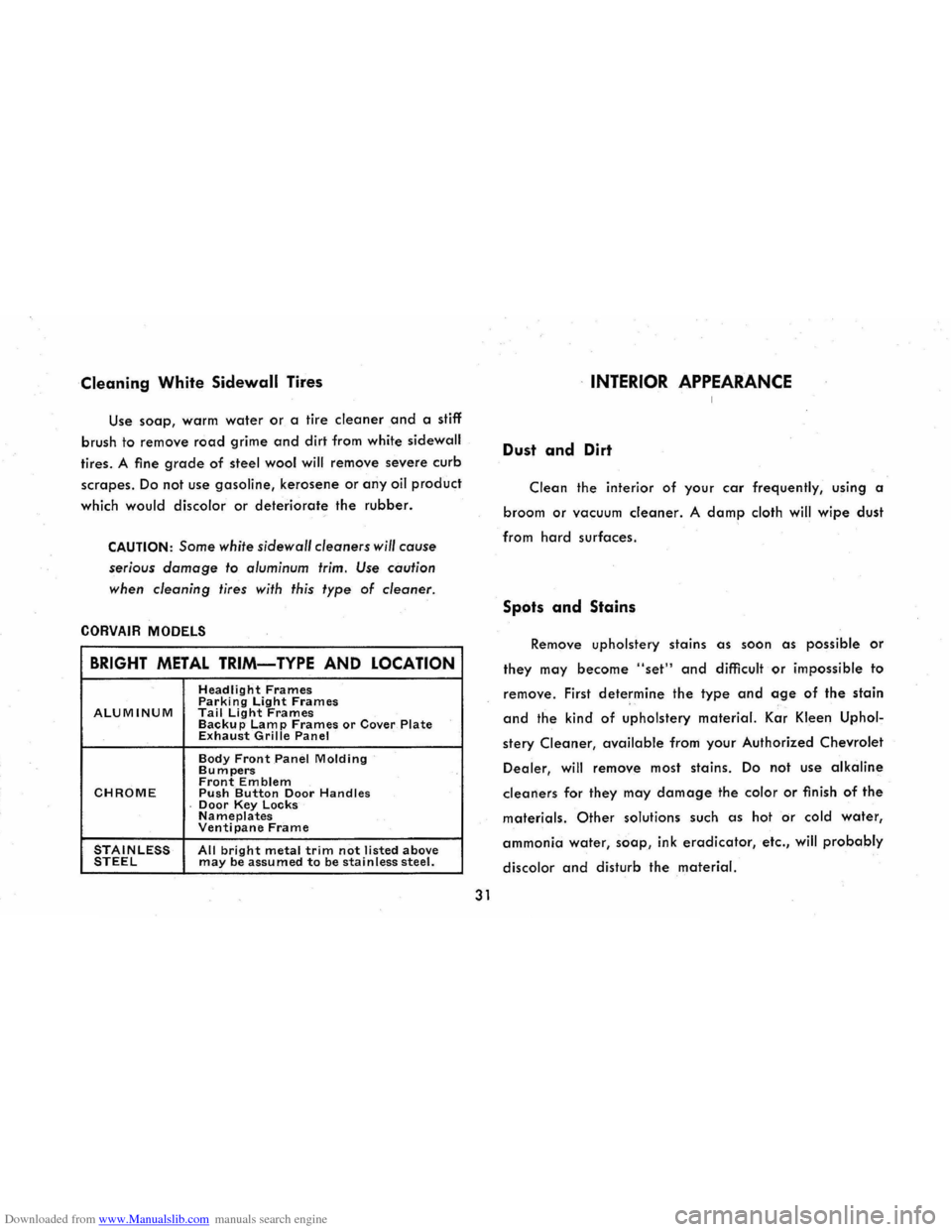
Downloaded from www.Manualslib.com manuals search engine Cleaning White Sidewall Tires
Use soap, warm water or a tire cleaner and a stiff
brush
to remove road grime and dirt from white sidewall
tires. A flne grade of steel wool will remove severe curb
scrapes.
Do not use gasoline, kerosene or any oil product
which would discolor or deteriorate the rubber.
CAUTION: Some white sidewall cleaners will cause
serious
damage to aluminum trim. Use caution
when cleaning tires with this
type of cleaner.
CORVAIR MODELS
BRIGHT METAL TRIM-TYPE AND LOCATION
Headlight Frames Parking light Frames ALUMINUM Tail light Frames Backup Lamp Frames or Cover Plate Exhaust Grille Panel
Body Front .Panel Molding Bumpers Front Emblem CHROME Push Button Door Handles Door Key Locks Nameplates Venti pane Frame
STAINLESS All bright metal trim not listed above STEEL may be assumed to be stainless steel.
31
INTERIOR APPEARANCE
Dust and Dirt
Clean the interior of your car frequently, using a
broom or vacuum cleaner. A damp cloth will wipe dust
from hard surfaces.
Spots and Stains
Remove upholstery stains as soon as possible or
they may become "set" and difficult or impossible to
remove . First determine the type and age of the stain
and the kind of upholstery material. Kar Kleen Uphol
stery Cleaner, available from your Authorized Chevrolet
Dealer, will remove most stains. Do not use alkaline
cleaners for they may damage the color or flnish of the
materials. Other solutions such as hot or cold water,
ammonia water, soap, ink eradicator, etc., will probably
discolor and disturb the material.
Page 35 of 56
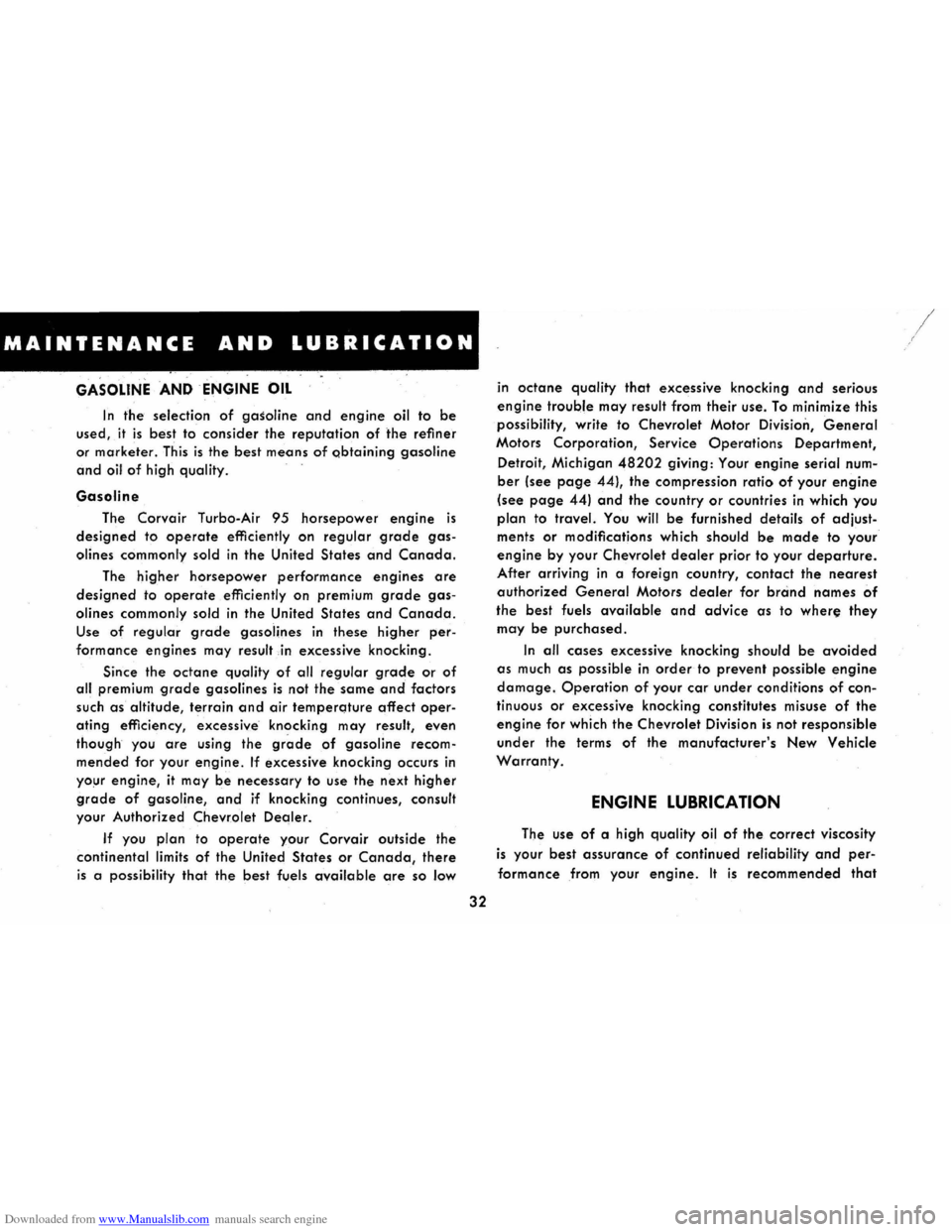
Downloaded from www.Manualslib.com manuals search engine MAINTENANCE AND LUBRICATION
GASOLINE AND ENGINE OIL
In the selection of gasoline and engine oil to be
used, it is best to consider the reputation of the refiner
or marketer. This is the best means of obtaining gasoline
and oil of high quality.
Gasoline
The Corvair Turbo-Air 95 horsepower engine is
designed to operate efficiently on regular grade gas
olines commonly sold in the United States and Canada.
The
higher horsepower performance engines are
designed to operate efficiently on premium grade gas
olines commonly sold in the United States and Canada.
Use of regular grade gasolines in these higher per
formance engines may result ,in excessive knocking.
Since the octane quality of all regular grade or of
all premium grade gasolines is not the same and factors
such as altitude, terrain and air temperqture affect oper
ating efficiency, excessive' knocking may result, even
though you are using the grade of gasoline recom
mended for your engine. If excessive knocking occurs in
your engine, it may be necessary to use the next higher
grade of gasoline, and if knocking continues, consult
your Authorized Chevrolet Dealer.
If you plan to operate your Corvair outside the
continental limits of the United States or Canada, there
is a possibility that the best fuels available are so low
32
in octane quality that excessive knocking and serious
engine trouble may result from their use. To minimize this
possibility, write to Chevrolet Motor Division, General
Motors Corporation, Service Operations Department,
Detroit, Michigan 48202 giving: Your engine serial num
ber (see page 44), the compression ratio of your engine
(see page 44) and the country or countries in which you
plan to travel. You will be furnished details of adjust
ments or modifications which should be made to your
engine by your Chevrolet dealer prior to your departure.
After arriving in a foreign country, contact the nearest
authorized General Motors dealer for brand names of
the best fuels available and advice as to where they
may be purchased.
In all cases excessive knocking should be avoided
as much as possible in order to prevent possible engine
damage. Operation of your car under conditions of con
tinuous or excessive knocking constitutes misuse of the
engine for which the Chevrolet Division is not responsible
under the terms of the manufacturer's New Vehicle
Warranty.
ENGINE LUBRICATION
The use of a high quality oil of the correct viscosity
is your best assurance of continued reliability and per
formancefrom your engine. It is recommended that
/ /
Page 36 of 56
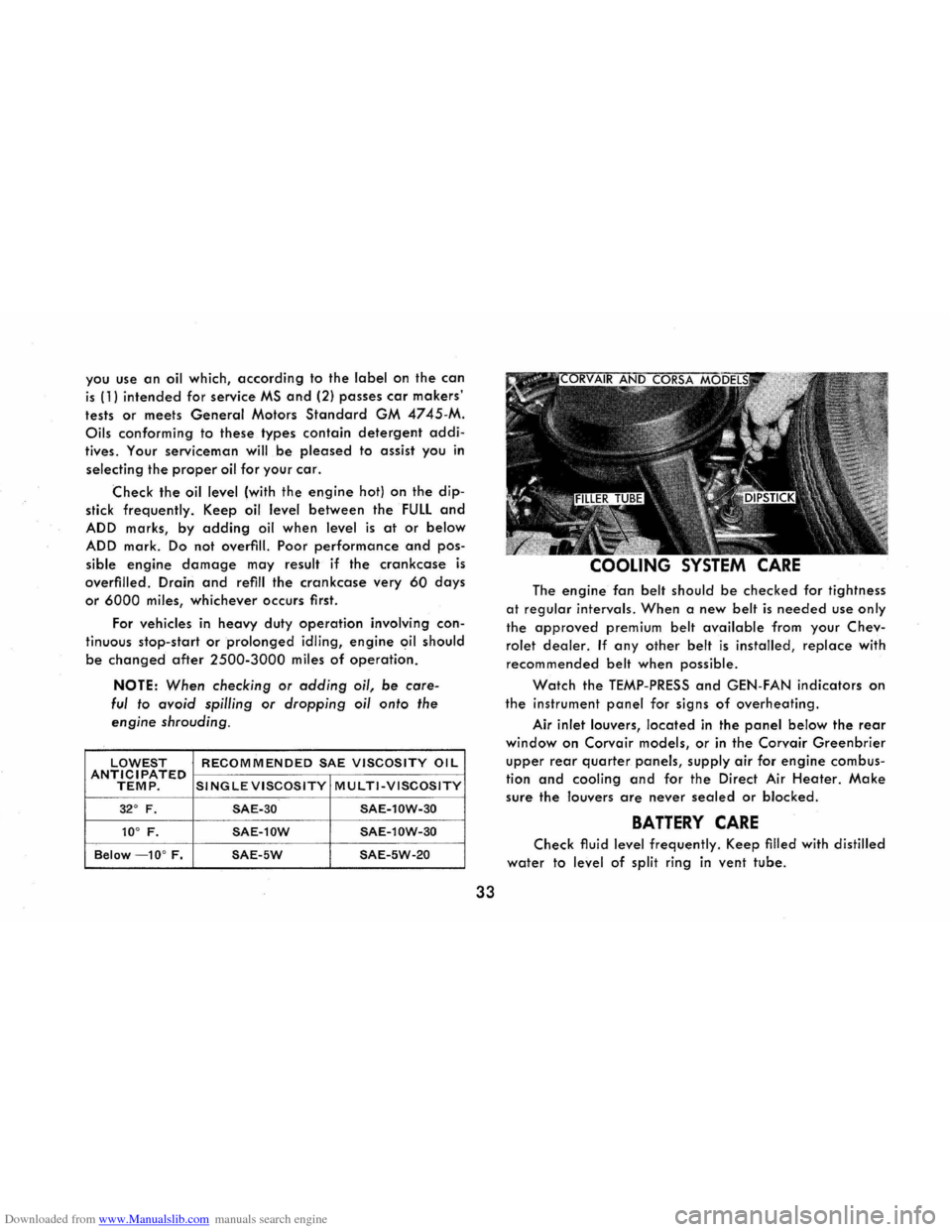
Downloaded from www.Manualslib.com manuals search engine you use an oil which, according to the label on the can
is (1) intended for service MS and (2) passes car makers'
tests or meets General Motors Standard GM 4745-M .
Oils conforming to these types contain detergent addi
tives. Your serviceman will be pleased to assist you in
selecting the proper oil for your car.
Check the oil level (with the engine hot) on the dip
stick frequently. Keep oil level between the FULL and
ADD marks, by adding oil when level is at or below
ADD mark. Do not overfill. Poor performance and pos
sible engine damage may result if the crankcase is
overfilled. Drain and refill the crankcase very 60 days
or 6000 miles, whichever occurs first.
For vehicles
in heavy duty operation involving con
tinuous stop-
start or prolonged idling, engine oil should
be changed after 2500-3000 miles of operation.
NOTE: When checking or adding oil, be care
ful to avoid spilling or dropping oil onto the
engine shrouding.
LOWEST RECOMMENDED SAE VISCOSITY OIL ANTICIPATED TEMP. SINGLE VISCOSITY MULTI-VISCOSITY
32° F. SAE-30 SAE-l0W-30
10° F. SAE-l0W SAE-l0W-30
Below -10° F. SAE-5W SAE-5W-20
33
COOLING SYSTEM CARE
The engine fan belt should be checked for tightness
at regular intervals. When a new belt is needed use only
the approved premium belt available from your Chev
rolet dealer. If any other belt is installed, replace with
recommended belt when possible .
Watch the TEMP-PRESS and GEN-FAN indicators on
the instrument panel for signs of overheating.
Air inlet louvers, located in the panel below the rear
window on Corvair models, or in the Corvair Greenbrier
upper rear quarter panels, supply air for engine combus
tion
and cooling and for the Direct Air Heater. Make
sure the louvers are never sealed or blocked.
BATTERY CARE
Check fluid level frequently. Keep filled with distilled
water to level of split ring in vent tube.
Page 37 of 56
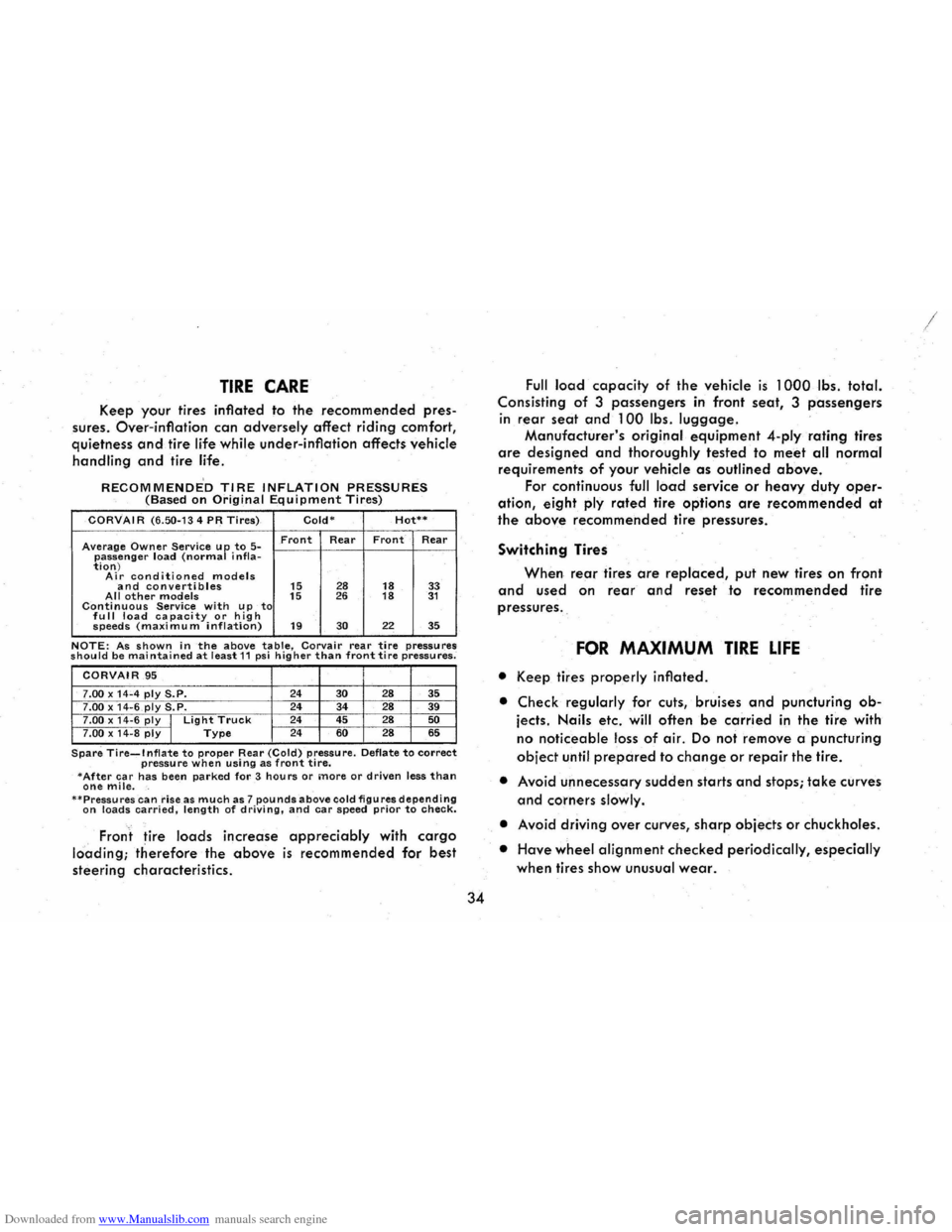
Downloaded from www.Manualslib.com manuals search engine TIRE CARE
Keep your tires inflated to the recommended pres
sures.
Over-inflation can adversely affect riding comfort,
quietness and tire life while under-inflation affects vehicle
handling and tire life.
RECOMMENDED TIRE INFLATION PRESSURES (Based on Original Equipment Tires)
CORVAIR (6.50-134 PR Tires) Cold-Hot**
Average Owner Service up to 5-Front Rear Front Rear
passenger load (normal i nfla-tion) Air conditioned models and convertibles 15 28 18 33 All other models 15 26 18 31 Continuous Service with up to fu II load ca pacity or h ig h speeds (maximu m inflation) 19 30 22 35
NOTE: As shown in the above table, Corvair rear tire pressures should be maintained at least 11 psi higher than front tire pressures;
CORVAIR .95
7.00 x 14"4 ply S.P. 24 30 28 35 7.00 x 14-6 ply S.P. 24
34 28 39 7.00 x 14-6 ply I Light Truck 24
45 28 50
7 .00 x 14 -8 ply I Type 24 60 28 65
Spare Tire...,.lnflate to proper Rear (Cold) pressure. Deflate to correct pressure when using as front tire. -After car has been parked for 3 hours or more or driven less than one mile. --Pressures can riseas much as 7 pounds above cold figures depending on loads carried, length of driving, and car speed prior to check.
, Fron t tire loads increase appreciably with cargo
lci'ading; therefore the above is recommended for best
steering characteristics.
34
Full load capacity of the vehicle is 1 OOOlbs. total.
Consisting of 3 passengers in front seat, 3 passengers
in
rear seat and 100 Ibs . luggage.
Manufacturer's original equipment 4-plyrating tires
are designed and thoroughly tested to meet all normal
requirements of your vehicle as outlined above.
For continuous full load service or heavy duty oper
ation, eight ply rated tire options are recommended at
the above recommended tire pressures.
Switching Tires
When rear tires are replaced, put new tires on front
and used on rear and reset to recommended tire
pressures. ,
FOR MAXIMUM TIRE LIFE
• Ke.ep tires properly inflated.
• Check regularly for cuts, bruises and puncturing ob
jects. Nails etc. will often be carried in the tire with
no noticeable loss of air. Do not remove a puncturing
object until prepared to change or repair the tire.
• Avoid unnecessary sudden starts and stops; take curves
and corners slowly.
•
Avoid driving over curves, sharp objects or chuckholes.
•
Have wheel alignment checked periodically, especially
when tires show unusual wear.
Page 38 of 56
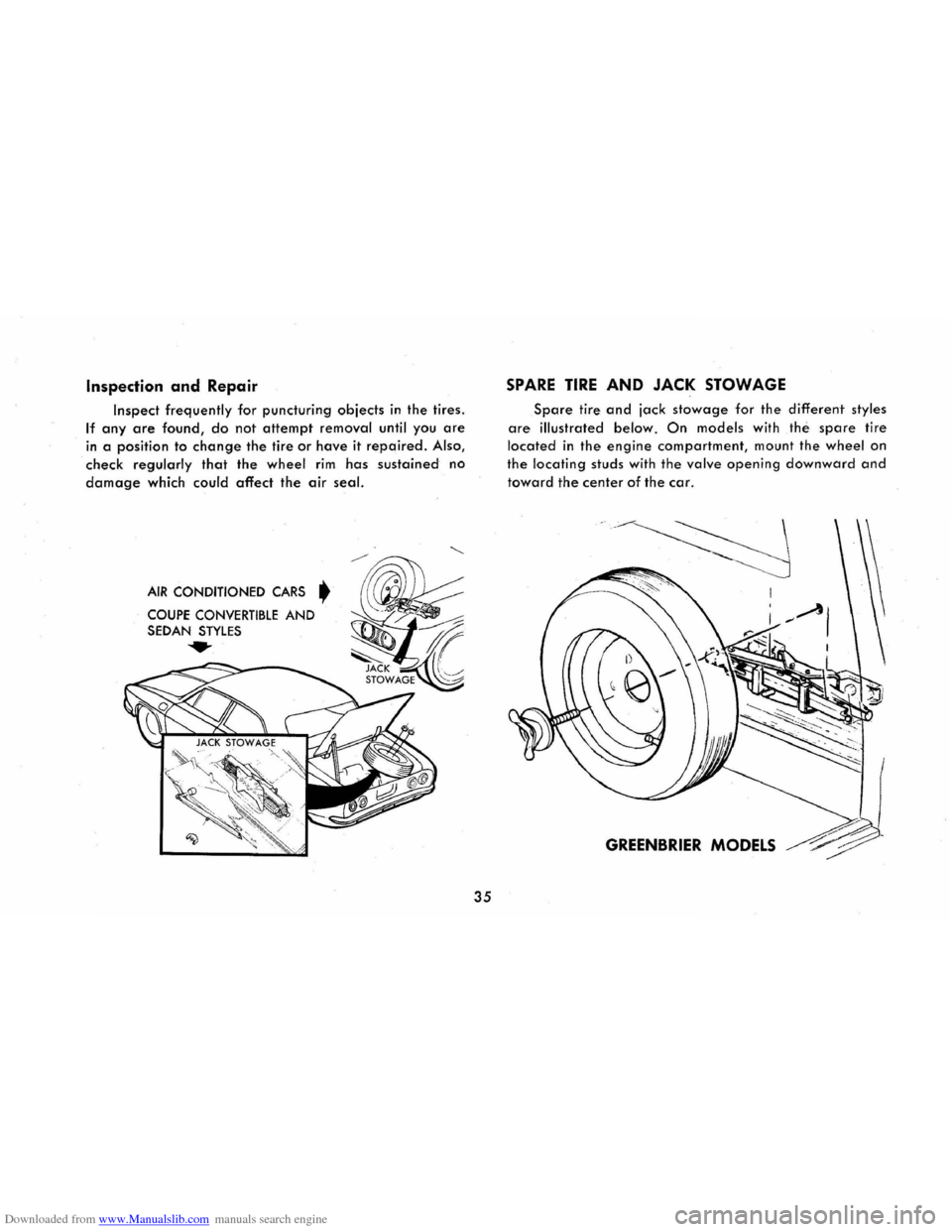
Downloaded from www.Manualslib.com manuals search engine Inspection and Repair
Inspect frequently for puncturing objects in the tires.
If any are found, do not attempt removal until you are
in a position to change the tire or have it repaired. Also,
check regularly that the wheel rim has sustained no
damage which could affect the air seal.
AIR CONDITIONED CARS •
COUPE CONVERTIBLE
AND SEDAN STYLES
....
35
SPARE TIRE AND JACK STOWAGE
Spare tire and jack stowage for the different styles
are illustrated below. On models with the spare tire
located in the engine compartment, mount the wheel on
the locating studs with the valve opening downward and
toward the center of the car.
GREENBRIER MODELS
Page 39 of 56
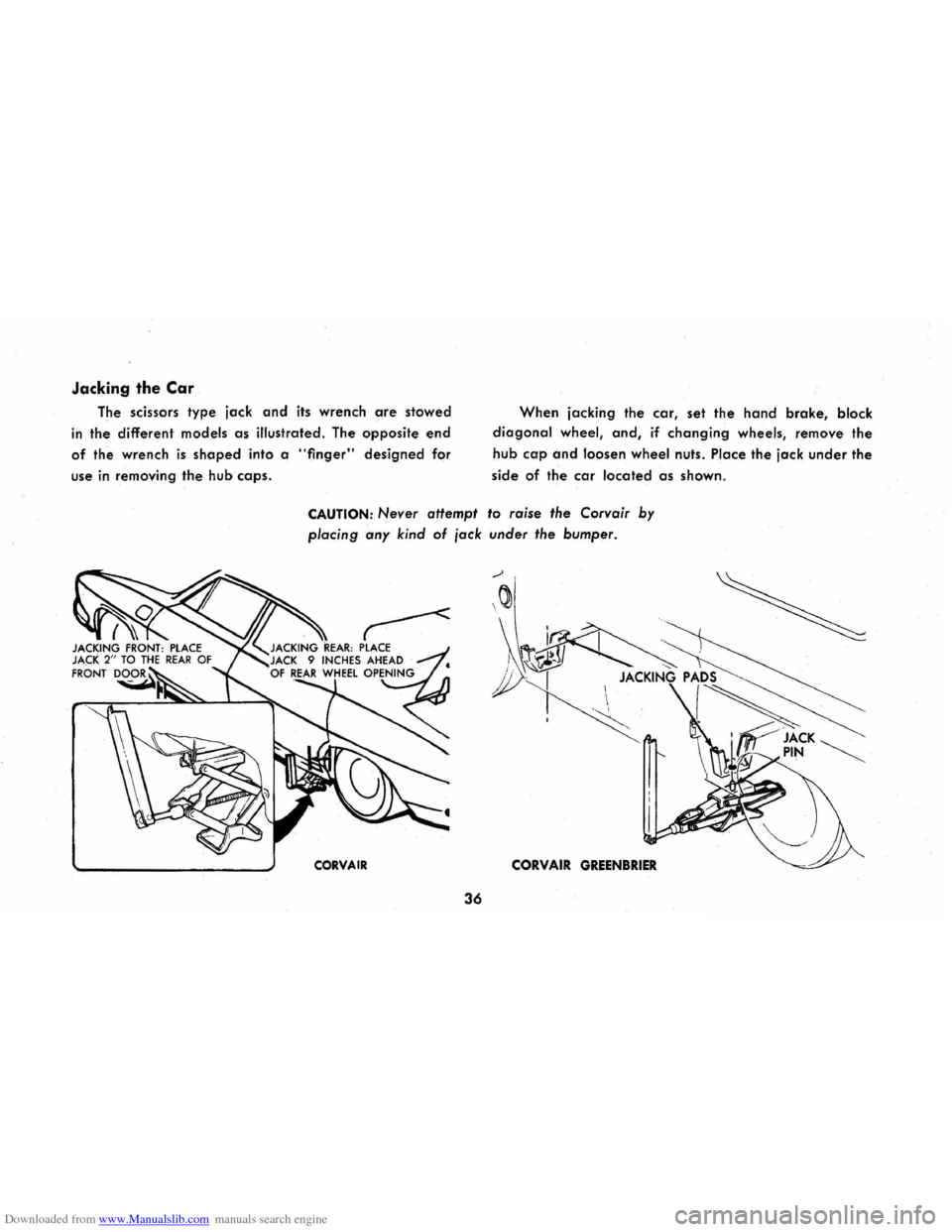
Downloaded from www.Manualslib.com manuals search engine Jacking the Car
The scissors type jack and its wrench are stowed
in the different models as illustrated. The opposite end
of the wrench is shopedinto a "finger" designed for
use
in removing the hub caps.
When jacking the car, set the hand brake, block
diagonal wheel, and, if changing wheels, remove the
hub
cap and loosen wheel nuts. Place the jack under the
side of the
car located as shown .
CAUTION: Never attempt to raise the Corvair by
placing any kind of jack under the bumper.
~
_~.,..-__ ~-.;:~_ ....... _~Of REAR WHEEl OPENING
JACKING REAR: PLAC~ JACK 9 INCHES AHEAD . •
CORVAIR CORVAIR GREENBRIER
36
Page 40 of 56
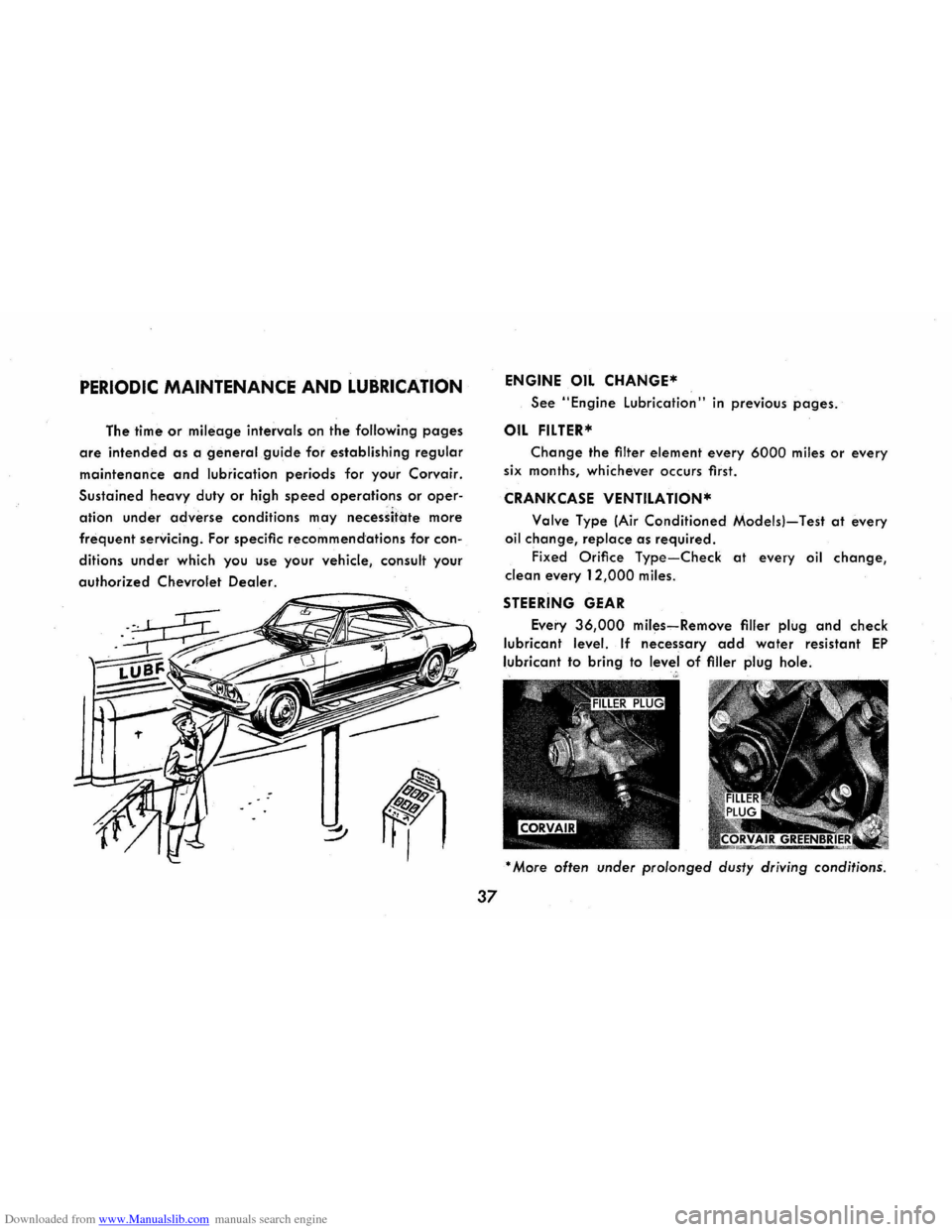
Downloaded from www.Manualslib.com manuals search engine PERIODIC MAINTENANCE AND LUBRICATION
The time or mileage intervals on the following pages
are intended as a general guide for establishing regular
maintenance and lubrication periods for your Corvair.
Sustained heavy duty or high speed operations or oper
ation under adverse conditions may necessitate more
frequent servicing. For specific recommendations for con
ditions under which you use your vehicle, consult your
authorized Chevrolet Dealer.
37
ENGINE OIL CHANGE*
See "Engine Lubrication" in previous pages.
OIL FILTER*
Change the filter element every 6000 miles or every
six months, whichever occurs first.
CRANKCASE VENTILA T10N*
Valve Type (Air Conditioned Models)-Test at every
oil change, replace as required.
Fixed Orifice Type-Check at every oil change,
clean every
12,000 miles.
STEERING GEAR
Every 36,000 miles-Remove filler plug and check
lubricant level. If necessary add water resistant EP
lubricant to bring to level of filler plug hole.
* More often under prolonged dusty driving conditions.